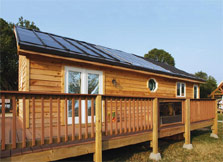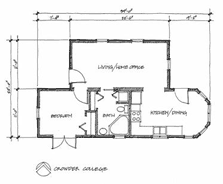

The Crowder College 2002 home looked like a French cottage but used cutting-edge technology.
Click drawing to view a larger image.

Solar Decathlon 2002
Crowder College
Final Overall Points: 725.001
Final Overall Standing: 6
Winner, Energy Balance
Winner, Home Business
Winner, Lighting
It's been a very educational and community-oriented process. It's not just the students participating in the project. Community members and sponsors have been jumping in and helping.—Monty Pugh-Towe, student team member
About the Home
Crowder College's team constructed its solar-powered house using electricity from its trailer-mounted, portable solar-electric system, becoming the only school that didn't use a gasoline generator for construction or assembly on the Mall. No diesel-powered cranes or forklifts were used, either; this was the only team that offloaded its house completely with hand cranks and jacks.
The Crowder students also stood out in terms of their use of solar energy, relying on amorphous thin-film, BP Millenia PV modules rather than the crystalline silicon modules found on the other houses. The modules were integrated into a standing seam metal roof so you could barely tell they were there. And Crowder's unique water heating system used the waste heat from the PV modules, through a system of copper tubes attached to the back of the modules and an extra layer of glazing added above the modules. This effectively turned each module into the absorber plate of a flat-plate solar water heating collector.
The team also paid special attention to ventilation. "Sick building syndrome" is a common building ailment in Crowder's home state of Missouri. Also, because of the state's high humidity, tight building construction is also a concern. So, the team worked hard to isolate yet ventilate the building envelope.
About the Team
How did tiny Crowder College pull off three first-place finishes in Solar Decathlon contests? The students, with backgrounds as varied as blacksmith art and computer science, used their community as an important resource. The two-year community college does not have an architecture or engineering department, so the team joined up with a local architect with an interest in adding solar technology to contemporary home designs.
Local sponsors donated building materials, visited the classrooms, and assisted with product installation. In return, students educated their sponsors about solar technologies and energy efficiency. Reaching out to the community helped the Crowder team design a contemporary cottage that is attractive, energy-efficient, and affordable.
"The greatest asset of a two-year school is that there are always fresh ideas. We ask a lot of questions and we scramble harder for the information. And, we reach out into the community for people with expertise," noted Art Boyt, the team's faculty advisor.
Key Home Features
| Item | Specifics |
|---|---|
| PV kilowatts (standard test condition rating) | 3.35 |
| PV modules | 78 BP Solar MST-43 |
| Charge controllers | 4 Solar Boost 3048 |
| Inverters | 2 Trace SW4048 |
| Battery bank | 800 ampere-hour, 48 volt |
| Battery type | 24 Eagle-Picher absorbed glass mat |
| Water heating | Thermal collectors integrated with 12 BP Solar Millenia PV modules; 250-gal (946-L) tank |
| Construction | 2 in. x 6 in. (5.1 cm x 15.3 cm) stud walls with FG batt; roof = R-40 (RSI 7); E2 Andersen windows |
| Space heating | Radiant floor |
| Space cooling | York 1.5 ton split system |
Manufacturers' Websites
- BP Solar
- Alternative Energy Systems Co. (Solar Boost)
- Xantrex (formerly Trace; Trace charge controllers)
- Eagle-Picher
- Andersen Windows
Source: These details have been adapted with permission from Home Power #94, April/May 2003
